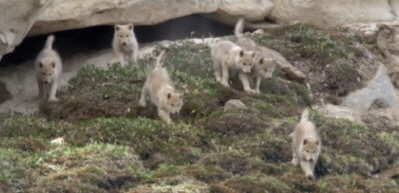Arctic Wolf
Life in a Barren Landscape

White Wolf
As spring advances, the transformation of the tundra continues, Migrants begin arriving from the south and suddenly the tundra is alive with birds and chicks. The Arcticís transformation is complete.
This influx of life is good news for some permanent residents. Food is rarely plentiful out on the tundra. The Arctic wolves must make the
most of this boom while it lasts.

Young Wolf Cubs
The wolves must gather as much food as they can. Many miles from here, other members of the pack are relying on them. This barren landscape
is a hard place to make a living, forcing wolf packs to be smaller here than further south.
Six hungry mouths to feed. The cubs are just over a month old. The ducks are devoured instantly, but on the long journey home, they also caught an Arctic hare, a mainstay of the tundra diet, and one the cubs seem to be particularly keen on.

Wolf Cubs Leaving the Den
Uneaten food is usually hidden for leaner times, but there will be no leftovers today. The cubs are growing fast and are always hungry. The good times are certainly back, but these white wolves remind us of the Arcticís less welcoming side. Their coats are pale to conceal them during the long snowy winter. Itís easy to forget that one month ago, this land was a barren white desert.

